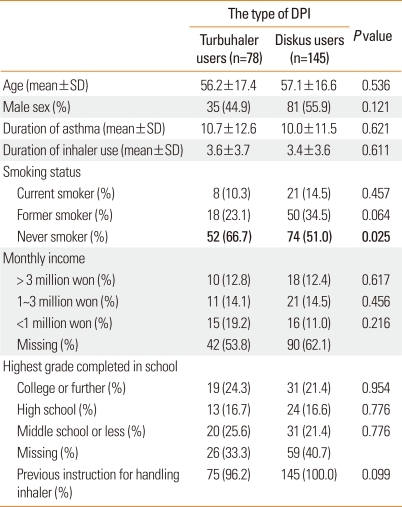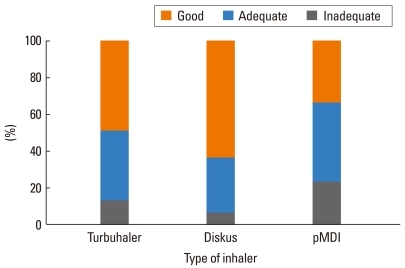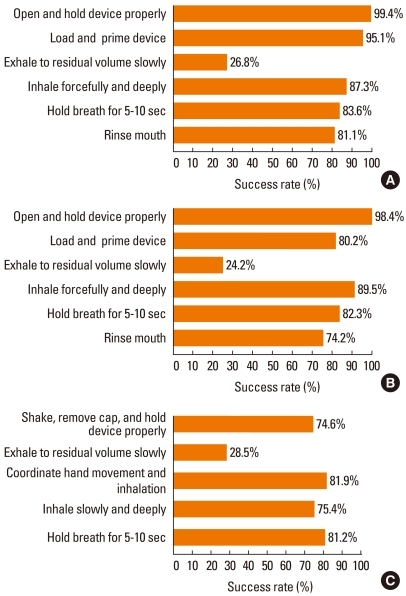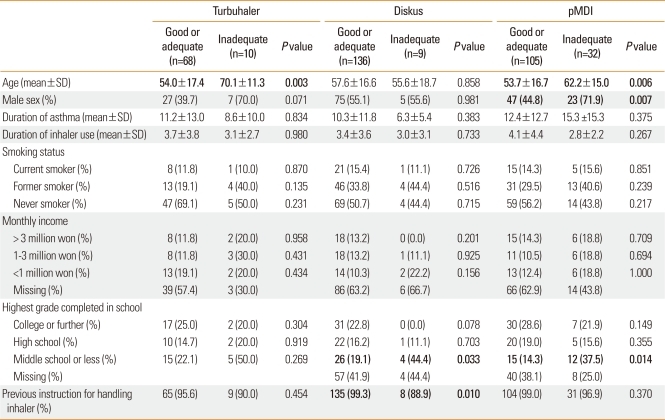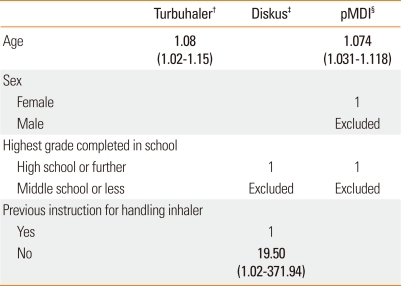Abstract
Purpose
The objective of this study was to evaluate skills in handling inhalers and factors associated with these skills among patients with asthma who had undergone treatment at special asthma and allergy clinics in Korea.
Methods
We enrolled 78 subjects who used Turbuhaler and 145 who used Diskus for asthma control at special clinics in 10 university hospitals and visually assessed their skills in handling these inhalers. We also evaluated skills in 137 subjects who had used pressurized metered-dose inhalers (pMDIs) for symptom relief. Age, sex, duration of asthma and inhaler use, smoking status, monthly income, highest grade completed in school and previous instruction for handling inhalers were also measured to evaluate their association with overall inhaler skills.
Results
Performance grade was inadequate for 12.8% of participants using Turbuhaler, 6.2% for Diskus, and 23.4% for pMDIs. The success rates for each step in handling the inhalers were relatively high except for the "exhale slowly to residual volume" step, in which success rates ranged from 24.2% to 28.5%. Older age, male sex, lower educational grade, and absence of previous instruction for handling inhalers were associated with inadequate inhaler technique in univariate analysis; however, only older age and absence of previous instruction remained significant independent risk factors in multivariate analysis.
Conclusions
Among Korean asthmatic patients in special asthma and allergy clinics, skills in handling their inhalers were mostly excellent; meanwhile, older age and absence of previous instruction for handling inhalers were associated with inadequate techniques.
Keywords: Asthma, Turbuhaler, Diskus, metered-dose inhaler
INTRODUCTION
Asthma is a chronic inflammatory airway disease, and inhaled medication is preferred for its treatment.1 The guidelines of the Global Initiative for Asthma (GINA) recommend regular use of inhaled corticosteroids with or without long-acting β2 agonists, and as-needed use of inhaled rapid-acting β2 agonists for symptom relief.1
In Korea, the forms of asthma control and symptom relief most frequently prescribed to asthma patients in outpatient clinics are dry power inhalers (DPIs) and pressurized metered-dose inhalers (pMDIs), respectively. DPIs mainly include Turbuhaler and Diskus, and a small number of patients use other devices, including Swinghaler. Inhaler devices including pMDIs or DPIs require patients to conduct multistep manipulations correctly, which they frequently fail to do.2,3 Moreover, instruction often fails to improve inhalation technique,4 and previous ability to use the inhaler correctly is not indicative of correct use during subsequent testing.5 Many asthma specialists frequently check whether patients use their inhalers correctly. If patients' skills in handling inhalers are not adequate, asthma specialists or instructors teach their patients to improve their techniques.
The objective of this study was to evaluate skills in handling inhalers, including Turbuhaler and Diskus, and pMDIs and to investigate factors associated with these skills in asthma patients who were undergoing treatment at special asthma and allergy clinics in Korea.
MATERIALS AND METHODS
Subjects
We enrolled 78 Turbuhaler users (Pulmicort and Symbicort; AstraZeneca, Seoul, Korea) and 145 Diskus users (Flixotide and Seretide; GlaxoSmithKline, Seoul, Korea) who visited 10 pharmacies near 10 university hospitals in Korea to purchase their inhalers. The inhalers were prescribed by asthma specialists at 10 university hospitals and were regularly used for asthma control. These devices were chosen because they are presently most commonly used by asthma patients in Korea. Patients usually used pMDIs such as Ventolin (GlaxoSmithKline, Seoul, Korea), Atrovent (Boehringer Ingelheim, Seoul, Korea), or Combivent (Boehringer Ingelheim, Seoul, Korea) for symptom relief on an as-needed basis. The institutional review board of the Korean Asthma Allergy Foundation (KAF) approved the study, and informed written consent was obtained from the patients.
Evaluation of adequacy in handling asthma controllers or symptom relievers
The subjects' performance skills in handling DPIs or pMDIs were visually assessed by interviewers at pharmacies to exclude the opinions or other influences that might have originated from doctors or other medical workers. Performance skills were not observed by the other participants. The interviewers were previously instructed and trained by an asthma specialist. The inhalation technique for DPIs, including Turbuhaler and Diskus, was evaluated for the following six aspects: 1) open and hold device properly; 2) load and prime device; 3) exhale slowly to residual volume; 4) inhale forcefully and deeply; 5) hold breath for 5-10 seconds; and 6) rinse mouth.6 We also evaluated skills in handling pMDIs among 137 subjects who used these devices for symptom relief. The manipulation of a pMDI was similarly evaluated for the following five aspects: 1) shake, remove cap, and hold device properly; 2) exhale slowly to residual volume; 3) coordinate hand movement and inhalation; 4) inhale slowly and deeply; and 5) hold breath for 5-10 seconds.6 In addition, overall technique for each inhaler was classified into three grades, good, adequate, and inadequate, based on levels of accomplishment of the defined steps.6 A participant was given a grade of good if he or she performed every step without exception.6 When a participant performed key steps, including "coordinate hand movement and inhalation," "load and prime device," and "inhale forcefully and deeply," but did not complete all the required steps, a grade of adequate was given.6 Those who failed any one of the key steps were graded as inadequate.6
Collection of other parameters including demographic and clinical characteristics
At pharmacies, the interviewers also collected demographic parameters including age, sex, duration of asthma, duration of inhaler use, smoking status, monthly income, and highest grade completed in school. They also asked subjects whether they had previously been instructed how to handle their inhalers.
Statistical analysis
Demographic data were compared according to the type of DPIs (Turbuhaler vs. Diskus) that subjects regularly used for asthma control using the Mann-Whitney U-test (continuous variables) and χ2 test (categorical variables). A comparison was also made between the good or adequate group and the inadequate group for each inhaler. A logistic regression model was constructed with inadequate overall technique in handling each inhaler as the dependent variable and demographic variables found to be associated with inadequate overall technique in handling the inhaler in univariate analysis as independent variables. A forward selection method was used to exclude multicollinearity of each variable. All of the statistical analyses were performed using a statistical software package (SPSS/PC WIN 17.0; SPSS Inc.; Chicago, IL, USA). P<0.05 was considered to indicate statistical significance.
RESULTS
Demographic and clinical characteristics
All subjects were undergoing treatment at special asthma and allergy clinics at one of 10 university hospitals. Demographic characteristics of patients according to the type of DPI (Turbuhaler vs. Diskus) used for asthma control are presented in Table 1. Age, sex, duration of asthma, and duration of inhaler use did not differ between the two groups. With regard to smoking status, the number of current and former smokers did not differ between the two groups; however, the proportion of never smokers among Turbuhaler users was higher than that among Diskus users. Monthly income, highest grade completed in school, and previous instruction for inhaler handling did not differ between the two groups.
Table 1.
Demographic characteristics of patients according to the type of DPI (Turbuhaler vs. Diskus) used for asthma control
Significant correlations are presented in boldface.
Technique for each step in handling the Turbuhaler, Diskus, and pMDIs
The overall assessment of inhaler technique showed that among Turbuhaler users, 48.7% were graded as good, 38.5% as adequate, and 12.8% as inadequate (Fig. 1). Among Diskus users, 63.4% were graded as good, 30.3% as adequate, and 6.2% as inadequate. For pMDI use, 33.6% of the subjects were graded as good, 43.1% as adequate, and 23.4% as inadequate. For Turbuhaler, the proportion of subjects who accomplished each step, i.e., "open and hold device properly," "load and prime device," "exhale slowly to residual volume," "inhale forcefully and deeply," "hold breath for 5-10 s," and "rinse mouth," was 99.4%, 95.1%, 26.8%, 87.3%, 83.6%, and 81.1%, respectively (Fig. 2A). For Diskus, the proportion of subjects who accomplished these steps was 98.4%, 80.2%, 24.2%, 89.5%, 82.3%, and 74.2%, respectively (Fig. 2B). For pMDIs, the proportion of subjects who accomplished each step, i.e., "shake, remove cap, and hold device properly," "exhale slowly to residual volume," "coordinate hand movement and inhalation," "inhale slowly and deeply," and "hold breath for 5-10 s" was 74.6%, 28.5%, 81.9%, 75.4%, and 81.2%, respectively (Fig. 2C).
Fig. 1.
Overall assessment of the technique for each inhaler. Sections of the bar indicate the percentage of subjects whose overall technique was determined to be good, adequate, or inadequate.
Fig. 2.
The proportion of subjects who accomplished each step of inhaler use. (A) Turbuhaler; (B) Diskus; (C) pMDI. The bars indicate the percentage of subjects who accomplished the associated steps.
Factors associated with inadequate inhaler techniques
We evaluated the factors associated with inadequate technique for the use of Turbuhaler, Diskus, and pMDIs. Comparisons were made between subjects with good or adequate technique and those with inadequate technique (Table 2). Older age was found to be associated with inadequate handling of Turbuhaler and pMDIs. Male sex was also associated with inadequate handling of pMDIs. For Diskus and pMDIs, the proportion of subjects with low educational grade (highest grade completed was middle school or less) was higher in the inadequate group than in the good or adequate group. Absence of previous instruction for inhaler handling was associated with inadequate handling of Diskus. A logistic regression model was constructed with inadequate overall technique in handling Turbuhaler as the dependent variable and age as the independent variable. Older age (odds ratio [OR], 1.08; 95% confidence interval [CI], 1.02-1.15) was found to be an independent risk factor for inadequate technique in handling Turbuhaler (Table 3). A logistic regression model was also constructed with inadequate overall technique in handling Diskus as the dependent variable and with highest grade completed in school and previous instruction for inhaler handling as independent variables. The results indicated that the absence of previous instruction for inhaler handling (OR, 19.50; 95% CI, 1.02-371.94) was an independent risk factor for inadequate technique in handling Diskus, whereas highest grade completed in school was excluded during forward selection. A logistic regression model was constructed with inadequate overall technique in handling pMDIs as the dependent variable and age, sex and highest grade completed in school as independent variables. The results showed that age (OR, 1.074; 95% CI, 1.031-1.118) was an independent risk factor for inadequate technique in handling pMDIs, whereas sex and highest grade completed in school were excluded during forward selection.
Table 2.
Factors associated with inadequate inhaler technique
Significant correlations are presented in boldface.
Table 3.
Adjusted odds ratios for inadequate inhaler technique*
*Odds ratios (95% confidence interval) with statistical significance are presented in boldface.
†A logistic regression model was constructed with inadequate overall technique for Turbuhaler as the dependent variable and age as an independent variable.
‡A logistic regression model was constructed with inadequate overall technique for Diskus as the dependent variable and highest grade completed in school and previous instruction for inhaler handling as independent variables.
§A logistic regression model was constructed with inadequate overall technique for pMDIs as the dependent variable and age, sex and highest grade completed in school as independent variables.
DISCUSSION
Subjects in the present study successfully accomplished most of the steps in handling Turbuhaler, Diskus, and pMDIs. In particular, the success rates of the key steps "coordinate hand movement and inhalation," "load and prime device," and "inhale forcefully and deeply," which are thought to be important in delivery of medication,6,7 were sufficiently high, and rates of good or adequate overall technique in handling Turbuhaler, Diskus, and pMDIs reached 87.2%, 93.8%, and 76.6%, respectively. In contrast, the most common error for both inhalers was in the step "exhale slowly to residual volume", which is consistent with previous studies.2,6,8,9 For sufficient delivery of drugs to target sites by inhalation, patients should prepare for inhalation by slowly and gently exhaling air in the lung to the residual volume.6,9
In handling pMDIs, the success rate of the first step, "shake, remove cap, and hold device properly" was relatively lower compared with handling DPIs, which was consistent with a previous study in which inhaler use by physicians10 or residents6,11 was evaluated. We should pay more attention to this step during training in the techniques for pMDI use.6 In addition, the success rates of other steps that are important for drug delivery, such as "coordinate hand movement and inhalation" and "inhale slowly and deeply" in handling pMDIs, were lower compared with those for "inhale forcefully and deeply" in handling Turbuhaler or Diskus. In some previous studies, subjects more frequently failed in handling pMDIs than DPIs,12,13 whereas other studies have suggested no difference between the two devices.3,14,15 A more difficult and complicated technique and infrequent and irregular use of a pMDI for symptom relief might prevent patients from adequately using these devices. Note that previous ability to use a pMDI correctly is not indicative of correct use during subsequent testing.5,16 The same phenomenon was observed in children.4 In our study, previous instruction for handling an inhaler was not related to overall adequacy in handling pMDIs, which contrasted with handling Turbuhaler. This suggests that in addition to the ability to learn the correct inhalation technique,17,18 the ability to remember the technique is an important determinant of using correct inhalation technique in the future.19 In this respect, we emphasize the importance of repeated instruction to reinforce the ability to retain a correct inhalation technique.20-22
In the present study, subjects with asthma who showed inadequate overall technique in handling Turbuhaler or pMDIs were significantly older than those who showed adequate overall technique, as previously reported.17,23-25 In particular, the association between older age and inadequate technique in handling inhalers remained significant in multivariate analysis. In elderly patients, cognitive function and the ability to learn have been reported to be important determinants of correct inhalation technique.17,18
With regard to sex, a previous report indicated that women had poorer inhalation technique than do men.25,26 Univariate analysis in our study indicated that male sex was associated with inadequate technique in handling pMDIs, which conflicts with previous studies. However, sex was excluded in the multivariate analysis.
With regard to socioeconomic status, monthly income was not associated with the correct use of DPIs or pMDIs in this study, which was in agreement with the previous report.27 Meanwhile, lower educational grade was significantly associated with the incorrect use of Diskus and pMDIs in our study, as reported previously.25 Lower educational grade can be associated with poorer reading level, and this has previously been shown to be the strongest predictor of MDI technique, along with knowledge about asthma.28 Therefore, written instructions are not sufficient for successfully training patients to use their inhalers correctly.21 Verbal instructions, multimedia educational materials, demonstrations, and practice sessions are all important components for successful use of inhaler devices.20,29 We emphasize that sufficient instructions for handling inhalers might be more important than the patient's educational grade, because although previous instruction for inhaler handling remained a significant independent risk factor for Diskus users, educational grade was excluded in our multivariate analysis. Duration of asthma diagnosis or inhaler use alone was not related to competence in use of DPIs and pMDIs in either the present or a previous study,17 which highlights the importance of instruction for handling inhalers.
There are some limitations to our study. Our subjects might not represent the general population with asthma in Korea. All of them regularly visited special asthma and allergy clinics in university hospitals and had already been taught how to use their inhalers. Their skills in handling inhalers were excellent compared with those reported in previous studies. The inhaler technique of other Korean asthma patients remains to be investigated. Most subjects in the present study replied that they had already been taught how to use their inhalers; however, we did not evaluate how often they had been instructed, or whether they had proper skills to use their inhalers after instruction. In addition, we did not measure inhaler compliance of asthma patients. Compliance is thought to be as important as handling skill for patients to achieve asthma control. Moreover, we did not evaluate the association of inhaler skill or compliance with asthma control or disease severity. We enrolled subjects at pharmacies and did not evaluate disease severity or asthma control. We are now undertaking a prospective study that will evaluate inhaler skills and compliance and their effects on achieving asthma control. Finally, data were missing for monthly income and educational status. It is possible that subjects with low educational status or monthly income did not respond properly.
In conclusion, Korean asthma patients who were undergoing treatment at special asthma and allergy clinics showed excellent skills in handling their inhalers. Older age and absence of previous instruction for inhaler handling were associated with inadequate inhaler technique.
ACKNOWLEDGMENTS
This study was supported by a grant from the Korea Asthma Allergy Foundation and AstraZeneca.
Footnotes
There are no financial or other issues that might lead to conflict of interest.
References
- 1.Global Initiative for Asthma. Global Strategy for asthma management and prevention. Bethesda: National Institutes of Health; 2009. [Google Scholar]
- 2.van Beerendonk I, Mesters I, Mudde AN, Tan TD. Assessment of the inhalation technique in outpatients with asthma or chronic obstructive pulmonary disease using a metered-dose inhaler or dry powder device. J Asthma. 1998;35:273–279. doi: 10.3109/02770909809068218. [DOI] [PubMed] [Google Scholar]
- 3.Campos A, Díaz MA, Muñoz MP, Liñana JJ, Martínez M, Lanuza MD. Assessment of the inhalation technique in asthmatic patients: a comparative study of three aerosol devices. Allergol Immunopathol (Madr) 1998;26:47–51. [PubMed] [Google Scholar]
- 4.Kamps AW, van Ewijk B, Roorda RJ, Brand PL. Poor inhalation technique, even after inhalation instructions, in children with asthma. Pediatr Pulmonol. 2000;29:39–42. doi: 10.1002/(sici)1099-0496(200001)29:1<39::aid-ppul7>3.0.co;2-g. [DOI] [PubMed] [Google Scholar]
- 5.Crompton GK. Problems patients have using pressurized aerosol inhalers. Eur J Respir Dis Suppl. 1982;119:101–104. [PubMed] [Google Scholar]
- 6.Kim SH, Kwak HJ, Kim TB, Chang YS, Jeong JW, Kim CW, Yoon HJ, Jee YK. Inappropriate techniques used by internal medicine residents with three kinds of inhalers (a metered dose inhaler, Diskus, and Turbuhaler): changes after a single teaching session. J Asthma. 2009;46:944–950. doi: 10.3109/02770900903229701. [DOI] [PubMed] [Google Scholar]
- 7.Fink JB, Rubin BK. Problems with inhaler use: a call for improved clinician and patient education. Respir Care. 2005;50:1360–1374. discussion 74-5. [PubMed] [Google Scholar]
- 8.Lavorini F, Magnan A, Dubus JC, Voshaar T, Corbetta L, Broeders M, Dekhuijzen R, Sanchis J, Viejo JL, Barnes P, Corrigan C, Levy M, Crompton GK. Effect of incorrect use of dry powder inhalers on management of patients with asthma and COPD. Respir Med. 2008;102:593–604. doi: 10.1016/j.rmed.2007.11.003. [DOI] [PubMed] [Google Scholar]
- 9.Self TH, Pinner NA, Sowell RS, Headley AS. Does it really matter what volume to exhale before using asthma inhalation devices? J Asthma. 2009;46:212–216. doi: 10.1080/02770900802492087. [DOI] [PubMed] [Google Scholar]
- 10.Plaza V, Sanchis J. Medical personnel and patient skill in the use of metered dose inhalers: a multicentric study. CESEA Group. Respiration. 1998;65:195–198. doi: 10.1159/000029259. [DOI] [PubMed] [Google Scholar]
- 11.Hanania NA, Wittman R, Kesten S, Chapman KR. Medical personnel's knowledge of and ability to use inhaling devices. Metered-dose inhalers, spacing chambers, and breath-actuated dry powder inhalers. Chest. 1994;105:111–116. doi: 10.1378/chest.105.1.111. [DOI] [PubMed] [Google Scholar]
- 12.Carrión Valero F, Maya Martínez M, Fontana Sanchis I, Díaz López J, Marín Pardo J. Inhalation technique in patients with chronic respiratory diseases. Arch Bronconeumol. 2000;36:236–240. doi: 10.1016/s0300-2896(15)30163-0. [DOI] [PubMed] [Google Scholar]
- 13.Cimas JE, González Vázquez de Prada I, del Castillo Arévalo F. The validation of checklists for the inhalation technic for the pressurized cartridge and the Turbuhaler. Arch Bronconeumol. 1999;35:15–19. doi: 10.1016/s0300-2896(15)30319-7. [DOI] [PubMed] [Google Scholar]
- 14.Melani AS, Zanchetta D, Barbato N, Sestini P, Cinti C, Canessa PA, Aiolfi S, Neri M. Inhalation technique and variables associated with misuse of conventional metered-dose inhalers and newer dry powder inhalers in experienced adults. Ann Allergy Asthma Immunol. 2004;93:439–446. doi: 10.1016/s1081-1206(10)61410-x. [DOI] [PubMed] [Google Scholar]
- 15.Casset A, Rebotier P, Lieutier-Colas F, Glasser N, Heitz C, Saigne J, Pauli G, de Blay F. Pharmacists' role in the management of asthma: a survey of 120 pharmacists in Bas-Rhin. Rev Mal Respir. 2004;21:925–933. doi: 10.1016/s0761-8425(04)71474-6. [DOI] [PubMed] [Google Scholar]
- 16.Paterson IC, Crompton GK. Use of pressurised aerosols by asthmatic patients. Br Med J. 1976;1:76–77. doi: 10.1136/bmj.1.6001.76-a. [DOI] [PMC free article] [PubMed] [Google Scholar]
- 17.Allen SC, Prior A. What determines whether an elderly patient can use a metered dose inhaler correctly? Br J Dis Chest. 1986;80:45–49. doi: 10.1016/0007-0971(86)90008-2. [DOI] [PubMed] [Google Scholar]
- 18.Allen SC. Competence thresholds for the use of inhalers in people with dementia. Age Ageing. 1997;26:83–86. doi: 10.1093/ageing/26.2.83. [DOI] [PubMed] [Google Scholar]
- 19.Connolly MJ. Inhaler technique of elderly patients: comparison of metered-dose inhalers and large volume spacer devices. Age Ageing. 1995;24:190–192. doi: 10.1093/ageing/24.3.190. [DOI] [PubMed] [Google Scholar]
- 20.Blaiss MS. Part II: Inhaler technique and adherence to therapy. Curr Med Res Opin. 2007;23(Suppl 3):S13–S20. doi: 10.1185/030079907X226168. [DOI] [PubMed] [Google Scholar]
- 21.Crompton GK, Barnes PJ, Broeders M, Corrigan C, Corbetta L, Dekhuijzen R, Dubus JC, Magnan A, Massone F, Sanchis J, Viejo JL, Voshaar T. The need to improve inhalation technique in Europe: a report from the Aerosol Drug Management Improvement Team. Respir Med. 2006;100:1479–1494. doi: 10.1016/j.rmed.2006.01.008. [DOI] [PubMed] [Google Scholar]
- 22.Kim SG, Jang AS, Kim YK, Lee S, Seo JP, Yang SW, Choi SI, Park SH, Lee KR, Park JH. The effect of patient education on correct use of metered dose inhalers in patients with asthma. J Asthma Allergy Clin Immunol. 2000;20:695–701. [Google Scholar]
- 23.Kamin WE, Genz T, Roeder S, Scheuch G, Cloes R, Juenemann R, Trammer T. The inhalation manager: a new computer-based device to assess inhalation technique and drug delivery to the patient. J Aerosol Med. 2003;16:21–29. doi: 10.1089/089426803764928329. [DOI] [PubMed] [Google Scholar]
- 24.van der Palen J, Klein JJ, Kerkhoff AH, van Herwaarden CL, Zielhuis GA, Seydel ER. Inhalation technique of 166 adult asthmatics prior to and following a self-management program. J Asthma. 1999;36:441–447. doi: 10.3109/02770909909087286. [DOI] [PubMed] [Google Scholar]
- 25.Park SY, Cho YS, Ji HS, Lee J, Kim YY, Lee TH, Lee CK, Yoo B, Moon HB. Evaluation of the inhalation performance in patients with asthma. J Asthma Allergy Clin Immunol. 2003;23:781–787. [Google Scholar]
- 26.Goodman DE, Israel E, Rosenberg M, Johnston R, Weiss ST, Drazen JM. The influence of age, diagnosis, and gender on proper use of metered-dose inhalers. Am J Respir Crit Care Med. 1994;150:1256–1261. doi: 10.1164/ajrccm.150.5.7952549. [DOI] [PubMed] [Google Scholar]
- 27.Walia M, Paul L, Satyavani A, Lodha R, Kalaivani M, Kabra SK. Assessment of inhalation technique and determinants of incorrect performance among children with asthma. Pediatr Pulmonol. 2006;41:1082–1087. doi: 10.1002/ppul.20498. [DOI] [PubMed] [Google Scholar]
- 28.Williams MV, Baker DW, Honig EG, Lee TM, Nowlan A. Inadequate literacy is a barrier to asthma knowledge and self-care. Chest. 1998;114:1008–1015. doi: 10.1378/chest.114.4.1008. [DOI] [PubMed] [Google Scholar]
- 29.Lee JK, Yang YH. Evaluation of an education program for patients with asthma who use inhalers. J Korean Acad Nurs. 2010;40:202–212. doi: 10.4040/jkan.2010.40.2.202. [DOI] [PubMed] [Google Scholar]



